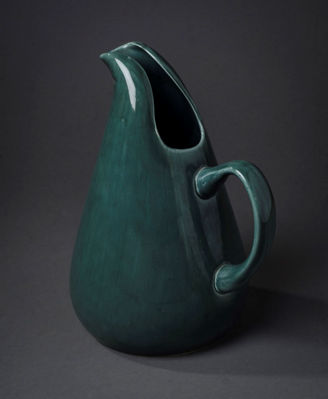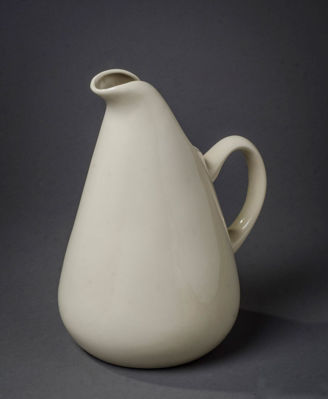Russel Wright
Between 1921 and 1924, Wright attended the Art Students League in New York and the Columbia University of Architecture. He began by apprenticing with Norman Bel Geddes, then a stage designer. In 1930, as a member of the American Union of Decorative Artists and Craftsmen (AUDAC), Wright exhibited his design of an aluminum cocktail shaker at AUDAC's exhibition in Manhattan. The design was such a success that Wright began a business with his wife Mary in 1930, designing and producing spun-aluminum accessories for the home In 1932, A Design for Machine exhibit in Philadelphia featured an all-aluminum breakfast room by Wright, showing lamps, tables, accessories, flatware and mugs in aluminum. Previously, aluminum was used primarily for pots and pans. Wright is credited as one of the first designers to explore its potential and for "bringing aluminum out of the kitchen." In 1932 Wright designed an early table model radio, and in 1933 he designed and produced sterling silver flatware which, though not produced in quantity, the Museum of Modern Art later commissioned production of replicas. An Art and Industry exhibit in 1934 at newly opened Rockefeller Center was organized by designers and showed 1000 products by 100 designers, including Wright, to illustrate "what designers are doing in the way of conscious creation of forms to help the engineer sell his mechanical devices." That same year, Wright was also included in a Metropolitan Museum exhibit, Contemporary American Industrial Art. Wright began designing furniture in 1934, including the first sectional sofa introduced by Heywood-Wakefield at Bloomingdale's. In 1935 he designed a natural maple line of furniture called Modern Living, made by Conant Ball Company for Macy's that was widely promoted. The popular line was later called American Modern, produced in bleached "blond" maple, and made Wright famous. He opened a showroom for his work, with the help of businessman Irving Richards, under the name Russel Wright, Inc. In 1938, with his reputation established by American Modern furniture, he established a "casual living" concept of accessories, and renamed his firm Russel Wright Accessories. At the 1939 World's Fair in New York, Wright designed the Food Zone exhibit in the Consumers Building. That same year, his design of an American Modern line of ceramic dinnerware was introduced, manufactured by Steubenville Pottery in East Liverpool, OH. It became a runaway success as the present to give a young bride, and sold over 80 million pieces. At a highly promoted patriotic event in December 1940 at Macy's featuring First Lady Eleanor Roosevelt, Wright launched a nationwide craft, design and merchandizing consortium of 100 designers called The American Way to promote low-cost American style to industry. Due to complexity of administration and national preoccupation with the war, it was abandoned within a year.
Sort by
Display per page




